
Largest New NEWP Wood Pellet Plant
February 16, 2012
By Dan Shell
Startup continues smoothly at New England Wood Pellet’s (NEWP) new Deposit, New York, plant, which opened in early June.
Startup continues smoothly at New England Wood Pellet’s (NEWP) new Deposit, New York, plant, which opened in early June.
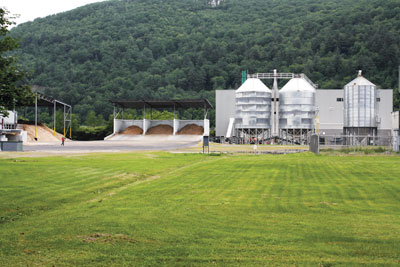 |
|
| NEWP’s new plant near Deposit, New York, is the largest in the Northeast United States and is scheduled to produce 85,000 tons annually for the domestic wood fuel pellet market.
|
The plant is the largest in the Northeast United States and is scheduled to produce 85,000 tons annually for the domestic wood fuel pellet market. The facility is the third for NEWP and has expanded overall company production by roughly 50%.
“The project startup is going well,” said NEWP CEO Steve Walker, an almost 20-year veteran of the pellet industry, in early July. “We’ve had multiple days running at full capacity, and we’re almost to 24/7 operating conditions right now.”
The $14.5-million plant is a big boost to the local community, operating on the site of a former Norbord Industries panel mill that NEWP purchased in November 2009 after it closed. More than $10 million in payroll, feedstock and supply purchases have been added to the local economy. The Deposit facility currently employs 16, and an estimated 100 additional jobs are supported in logging, trucking, supplier and pellet retailer activities.
Walker noted the new plant is “perfectly located to supply all of southern New York, eastern Pennsylvania and northern New Jersey. We’re making a major contribution to helping the region achieve greater energy independence by reducing reliance on imported and expensive heating oil and propane.”
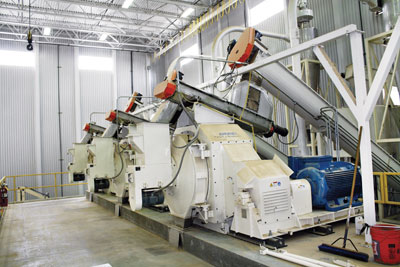 |
|
| The Deposit plant is the third for NEWP and boosts overall company output by roughly 50%. |
He added that, although many plant operators try to locate facilities in an area with low wood costs, he takes a different approach and seeks a location in proximity to the nearest major markets. As a result, the plant procures material from many smaller sources, as opposed to a rural plant that may have a supply agreement with a large landowner. At the same time, transportation costs are lower. There’s only a finite amount of dollar value loaded onto a truck, and once transportation costs begin eating too heavily into margins, hauling distance must be limited, Walker said.
The new pellet plant is the fifth such project for Walker, who started NEWP in 1992. The company also operates pellet plants in Jaffrey, New Hampshire and Schuyler, New York.
At the Deposit plant, a compact design includes an MEC triple-pass dryer, two 500 HP Bliss hammermills, three Andritz pellet mills (with provisions for a fourth) and an automated Hamer bagging line feeding to a Wulftec shrink wrap turntable. Fired by a Wellons burner, the dryer is oversized and allows lower drying temps that help reduce volatile organic compound (VOC) emissions. Other key components include a 14-metre Peerless truck dump, Carrier vibrating conveyors, BM&M screening systems, Kice baghouse, in-house designed cyclones, and Allen-Bradley PLCs and control systems.
Safe Design
Engineering and building safety as part of plant design is a big emphasis for Walker, who said he believes in assuming incidents will happen but working as hard as possible to prevent them, and to mitigate damages if they do occur.
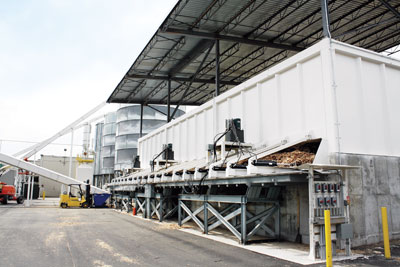 |
|
| The three-bay live bottom infeed system receives raw material and directs it to a Wellons step-grate burner for lower grade fuel or to the Carrier vibrating conveyor system, which feeds a Bliss 500 HP green hammermill.
|
“We do all our explosion venting through the walls. It’s engineered in, and we go way above the code required and tend to overdo it,” he said. Walker also described the plant’s production building as “full of holes” from the conveyor penetrations and explosion venting systems.
The plant utilizes a Firefly spark detection system and complements that with extensive heat monitoring throughout the plant.
“We’re always monitoring, basically, anywhere you’re moving air, and also places like bearings and gearboxes. We use thermocouples throughout the plant,” Walker added.
Precaution is evident from front to back, from the screening system that removes and bypasses fines from the first hammermill and the lower operating temps on the dryer, to the custom dry storage silos with fabric tops feeding the pellet mills and the separate coolers for each mill.
The central control system is another example: Designed so one central Allen-Bradley new-generation MCC PLC system operates and monitors every machine in the plant, the control system features proprietary NEWP operating software that incorporates years of pellet mill experience and acquired expertise.
“We have a lot of safety monitoring built into the control system that anticipates problems and seeks to avert them or better deal with them if they do occur,” he said.
He added that following up on maintenance and good housekeeping is critical to safety system performance. For example, explosion venting panels must be constantly monitored for material accumulation or icing in cold weather.
Mill Flow
For feedstock, the plant seeks out chips with low or no bark content, though some mill residuals, such as sawdust, are accepted. The plant is designed to run on 100% green chips. “We built a pad for on-site chipping if needed,” Walker said, “but we’re trying to avoid that.”
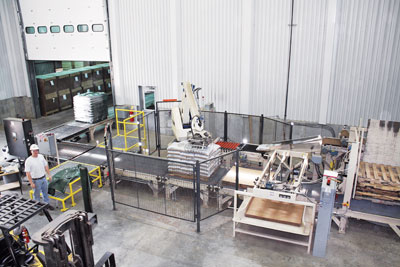 |
|
| A Fuji robot that takes each bag and places it on the pallet aids the production area and is virtually trouble-free.
|
Incoming trucks are self-unloaded or tipped using a Peerless truck dump, which empties onto a paved area that features a large 40,000-square-foot covered storage shed, and three-bay live bottom infeed system. Wheel loaders move and mix incoming raw material either to the storage area or straight to the infeed bays. One bay feeds material to the Wellons step-grate burner, which can handle lower grade fuel, and the other two bays work together to create an even flow to the Carrier vibrating conveyor system, which feeds a Bliss 500 HP green hammermill.
Walker noted that the drive-in bays were designed for easy access and maintenance, and the moving floor system, designed in house was designed to handle icy material and still perform well.
The vibrating conveyor feeds a BM&M screening system preceding the green hammermill, which removes the finest material.
Fines bypass the hammermill and are reblended before they reach the dryer, reducing wear on the hammermill and giving an added degree of fire protection.
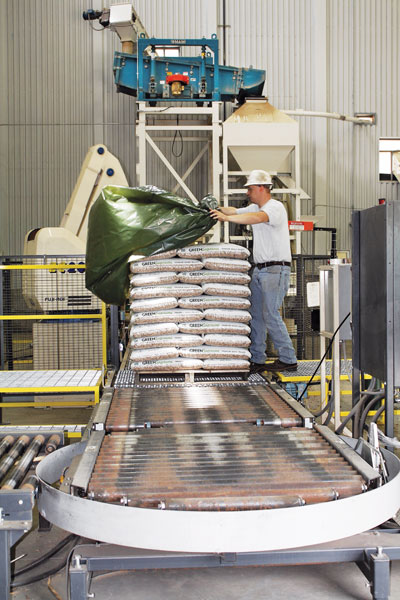 |
|
| At the new plant, the back end features automatic Hamer bagging and a Wulftec shrink wrap turntable.
|
The plant’s oversized MEC triple-pass dryer operates at 315 C, a temperature that greatly reduces VOCs, and features with six in-house designed, high-efficiency cyclones. After drying, raw material is processed again through a dry end 500 HP Bliss hammermill for final sizing before pellet production. Raw material ready for pelletizing is routed to two custom live-bottom silos that feed the metering systems.
The plant’s three Andritz pellet mills each have their own custom raw material metering system above and separate coolers below, as well as separate cyclone systems, a safety feature that diffuses fire risk by separating hot pellets into three areas instead of one large cooling tower.
From the production area, pellets proceed to a Hamer automated bagging line and Wulftec shrink wrap turntable aided by a Fuji robot that takes each bag and places it on the pallet.
“We really like the robots,” Walker said regarding the fourth robot operated by NEWP across its three mills. “They’re very low maintenance and consume very little energy,” he adds, noting that the biggest challenge in working with robots is designing the proper attachment for the end of the robot arm that’s actually handling the work piece. Performance, programmability and maintenance are otherwise virtually trouble-free.
The company continues to try to expand sales into commercial bulk fuel accounts. The segment is growing more than bag fuel markets, but still remains a small part of NEWP’s overall business, Walker said.
One issue facing the domestic pellet industry is the evolution of heating systems and pellet utilizations to encompass homes, business boilers and furnace products that work with central heating/air systems or other appliances.
“It’s a real bottleneck in our industry as far as efforts to make those systems available, because right now they are too expensive, and there are no real turnkey systems available,” Walker said.
Print this page